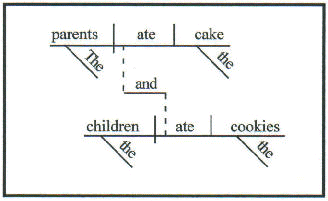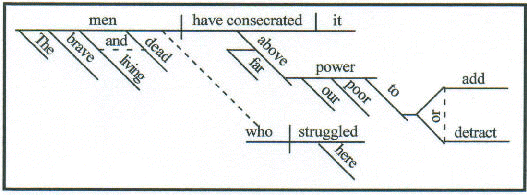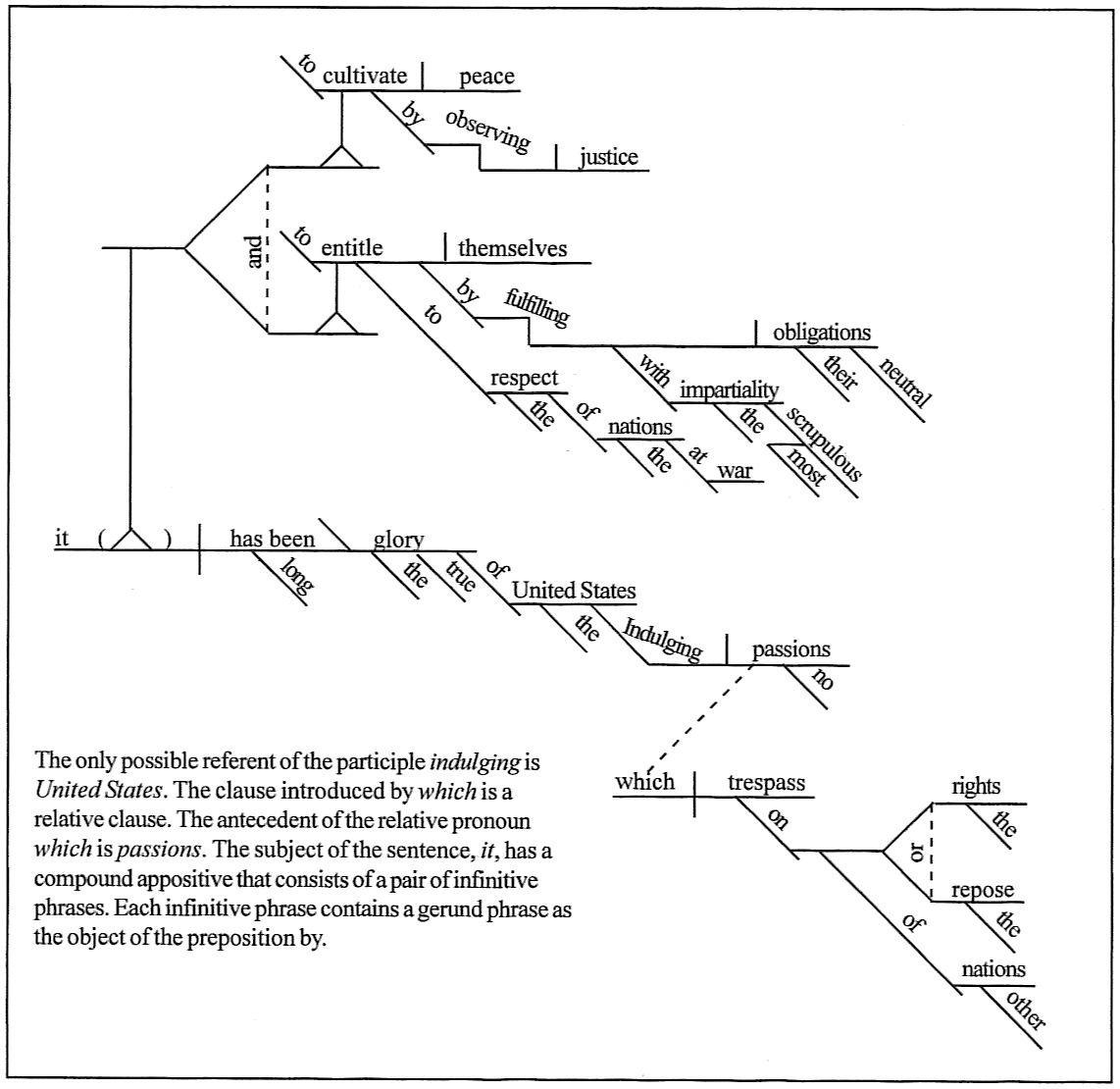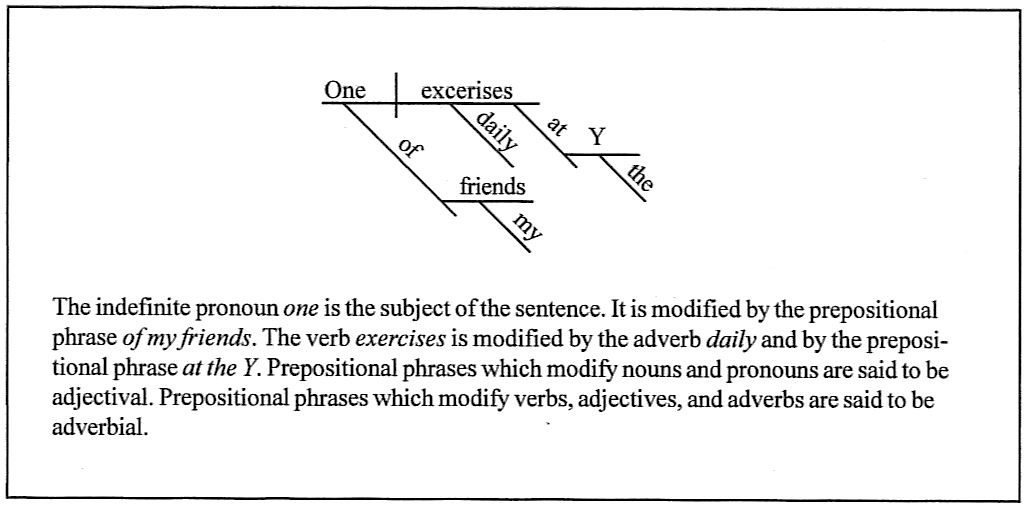English
500 Sentence Diagrams
English Grammar and Usage
by Eugene R. Moutoux
| As a foreign-language teacher, I was often disturbed by the inability of my first-year students to deal effectively with even the most basic elements of grammar. Whereas in a bygone era elementary-school students learned the parts of speech and their respective functions (and demonstrated this knowledge by diagramming sentences), today's students enter high school unsure of the difference between nouns and verbs, and totally befuddled if asked to identify gerunds and participles, direct objects, and predicate nominatives. Perhaps you are one of these students. If so, welcome to my website, which I hope will familiarize you with as much grammar as you will need to know. If you already have a solid foundation in grammar, you will perhaps enjoy creating your own diagrams before looking at mine. If we disagree and you think you're right, please let me know. I'll be happy to write back. |
|
Click on items below to get started. |
|
The Basics of Sentence Diagramming (Part One) 30 sentence diagrams introducing subjects verbs attributive adjectives adverbs prepositional phrases direct objects indirect objects predicate nominatives predicate adjectives conjunctions . . . and more
Examples: Click on the diagram to enlarge it. Sentence 1: They laughed.
Sentence 22: Several students in her class speak with the confidence of Demosthenes. |
The Basics of Sentence Diagramming (Part Two) 30 sentence diagrams introducing possessive nouns objective complements adverbial objectives adverb clauses adjective clauses noun clauses participles gerunds infinitive phrases compound-complex sentences . . . and more
Examples: Sentence 31: The parents ate the cake, and the children ate the cookies.
Sentence 51: She earned a promotion by completing her projects promptly.
|
Grammatical Terms and Diagramming Symbols Click on a page to enlarge it. . . . from "absolute phrase" to "complementary infinitive"
. . . from "complex sentence" to "finite verb"
. . . from "future tense" to nominative absolute"
|
. . . from "noun" to "phrasal verb"
. . . from "phrase" to "relative pronoun"
. . . from "retained object" to "voice"
Nouns, Pronouns, Verbs, Adjectives, Adverbs, Conjunctions, Prepositions, Expletives, Subjects, Direct Objects, Predicate Nominatives, Predicate Adjectives, Prepositional Phrases, Indirect Objects, Objective Complements, Adverbial Objectives, Retained Objects, Possessives, Imperatives, Vocatives, Infinitives, Gerunds, Participles, Adverb Clauses, Adjective Clauses, Noun Clauses, Compound-Complex Sentences |
|||||||
|
Long Sentences from the First Pages of Literature 10 diagrams Sentences by Charles Dickens Benjamin Franklin Robert Graves Edith Hamilton Henry Fielding Thomas Wolfe Oliver Goldsmith Sir Walter Scott Nathaniel Hawthorne John Milton
|
Example:
Sentence 1. "There once lived, in a sequestered part of the country of Devonshire, one Mr. Godfrey Nickleby: a worthy gentleman, who, taking it into his head rather late in life that he must get married, and not being young enough or rich enough to aspire to the hand of a lady of fortune, had wedded an old flame out of mere attachment, who in her turn had taken him for the same reason." -- Nicholas Nickleby, by Charles Dickens (first sentence of the novel) Click on the diagram to enlarge it. |
Anatomy of a Sentence Diagramming a 100-Word Sentence Step by Step 1 long diagram . . . and 15 steps to get there You will see how to diagram subjects, verbs, attributive adjectives, predicate adjectives, adverbs, direct objects, indirect objects, prepositional phrases, coordinating conjunctions, subordinating conjunctions, relative adverbs, adverbial objectives, objective complements, compound expressions, independent expressions, relative clauses, noun clauses, adverb clauses, appositives, past participles, present participles, and infinitive phrases while you examine each step and read the accompanying explanations. |
Example:
Every year on the afternoon of December 24, you, a Christmas procrastinator, loaded down with sacks and boxes, walk from store to store, down endless aisles, your eyes scanning windows and racks to find the perfect presents for Mom, Grandpa, and Uncle Joe, but since you know in your heart of hearts that Uncle Joe will appreciate nothing you give him and that you will capitulate to necessity and buy Grandpa a fifth of Seagram’s, you concentrate on Mom, as you move into the aisle that you hope to be able to call the final stop of this holiday season. Step 1: |
|||||||
|
36 diagrams of German sentences
There's nothing else like this on the Internet! |
Examples:
Sentence 13. Gestern hat meine Kusine angerufen und mich zum Kaffee eingeladen. Sentence 30. Ilse bekam eine Rechnung für das, was sie nicht bestellt und nicht gegessen hat.
|
65 diagrams of Latin sentences
There's nothing else like this on the Internet! |
Examples:
Sentence 18. Ille homo pater appellatur qui liberos suos curat. Sentence 36. Multam pecuniam dare est divitias maiores habere. |
|||||||
|
Diagrams of Sentences by Contemporary Journalists 20 diagrams New York Times Washington Post Associated Press Los Angeles Times Gannett News Service Louisville Courier-Journal
|
Example:
Sentence 1. "The federal government and many of the nation's leading telephone companies yesterday announced an agreement for a reshuffling of phone rates that would reduce the bills of tens of millions of less affluent consumers and lead to less significant cuts for other consumers and businesses." - Stephen Labaton, The New York Times (published on June 1, 2000, in Louisville, KY, in The Courier-Journal, page A1) Click on the diagram to enlarge it. |
Diagrams of Sentences from the U.S. Constitution and Declaration of Independence 17 diagrams Preamble Amendments 1- 10 (Bill of Rights) Amendment 13 Amendment 15 Amendment 16 Amendment 18, Section 1 Amendment 19. Section 1 Opening Sentence of the Declaration of Independence
|
Example:
Preamble. "We the people of the United States, in order to form a more perfect Union, establish justice, insure domestic tranquility, provide for the common defense, promote the general welfare, and secure the blessings of liberty to ourselves and our posterity, do ordain and establish this Constitution for the United States of America." Click on the diagram to enlarge it. |
|||||||
|
There are only ten sentences in "The Gettysburg Address." Do you know which sentence is the longest?
The Gettysburg Address Diagrammed 10 diagrams
The last sentence is by far the longest. It has 82 words. |
Examples:
Sentence 1. "Four score and seven years ago our fathers brought forth on this continent, a new nation, conceived in Liberty, and dedicated to the proposition that all men are3 created equal." Sentence 7. "The brave men, living and dead, who struggled here, have consecrated it, far beyond our poor power to add or detract." |
Presidential Inaugural Addresses Diagrammed 44 diagrams Five U.S. presidents did not deliver an inaugural address: John Tyler, Millard Fillmore, Andrew Johnson, Chester Arthur, and Gerald Ford. For the first four, I have taken sentences from their first annual messages. For Gerald Ford, I used a sentence from a brief speech he gave upon taking the oath of office following the resignation of Richard Nixon. One president, Grover Cleveland, was both the 22nd and the 24th president. I selected one sentence from each of his inaugural addresses. I have tried to choose sentences that impress me for historical, intellectual, and linguistic reasons, not by reason of partisan political content.
The longest sentence in this section has 112 words. It was spoken by George Washington. |
Example:
"Indulging no passions which trespass on the rights or the repose of other nations, it has been the true glory of the United States to cultivate peace by observing justice, and to entitle themselves to the respect of the nations at war by fulfilling their neutral obligations with the most scrupulous impartiality." James Madison (4), First Inaugural Address (March 4, 1809) Click on the diagram to enlarge it. |
|||||||
|
Archives of "The Daily Diagram" 250 Diagrams
Teachers, You may want to select from these archives one sentence each day and challenge your students to diagram it. In time, many students will look forward to your "Diagram of the Day." Examples: Day 1. All insects have six legs. Day 2. One of my friends exercises daily at the Y. Click on the diagram to enlarge it.
|
Examples:
Day 3. The individual players were outstanding; however, they didn't play hard enough to win the conference championship. Click on the diagram to enlarge it. Day 34. Her decision was to go to the police and report that her friend was the terrorist everyone had been looking for. Click on the diagram to enlarge it.
|
Examples: Day 109. Do you think that those people who say they prefer that their birthday pass unmentioned really mean it? Click on the diagram to enlarge it. Day 221. He said he was as good as or better than any other player in the NBA. Click on the diagram to enlarge it.
|
Example:
Day 250. Although people with excellent writing and speaking skills but with little or no formal knowledge of grammar are unable to participate fully in a conversation about such germane topics as the proper use of participles, the correct choice of the pronouns "who" and "whom," the placement of possessives before certain gerunds, and the avoidance of redundant relative pronouns, they nevertheless can and do, by their positive modeling, act as powerful counterweights to the destructive forces in society that constantly introduce and propagate mindless changes in the grammar of the language--changes which, if left unchecked, would quickly spiral out of control. (101 words) Click on the diagram to enlarge it. |
|||||||
|
My Books of Sentence Diagramming Click on a book cover to read about the book and to view several of its pages. |
 |
 |
 |
|
The system of diagramming used on this web site and in my books of sentence diagramming was introduced by Stephen Clark in 1847, modified by Alonzo Reed and Brainerd Kellogg some thirty years later (Higher Lessons in English: A Work of English Grammar and Composition, Clark and Maynard, 1884), and expanded by Homer C. House and Susan Emolyn Harman in 1931 (Descriptive English Grammar, 2nd ed., Prentice Hall, 1950) and by Martha Kolln in 1982 (Understanding English Grammar by Martha Kolln and Robert Funk, 8th ed., Bingo, 2009). I have tried to follow in their footsteps (and to create a few of my own) with my books Drawing Sentences: A Guide to Diagramming (Butler Books, 2010), Diagramming Step by Step: One Hundred and Fifty-Five Steps to Excellence in Sentence Diagramming (Butler Books, 2013), and Analyzing the Grammar of Literature: Diagrams of 130 Long Sentences from British and American Writers. |
| If
you want me to explain the grammar of a sentence, please email
the sentence to me. If possible, ask specific questions about
the sentence.
I will not diagram sentences for you. |
Please send comments and questions to
Return to my home page, German-Latin-English
For information about all of my books, click here.
| I
recommend . . .
For information about the early history of sentence diagramming: Kitty Burns Florey's delightful book about sentence diagramming, Sister Bernadette's Barking Dog, won't teach you how to diagram; but if you like diagramming, you'll love this book with its happy combination of scholarship and reminiscence. Visit Florey's website at http://www.kittyburnsflorey.com/. To get a taste of her style, read her essay entitled "Boring Things," which is anything but boring. It's on the third page of her website. http://www.polysyllabic.com/?q=olddiagrams. For thoughts about the importance of learning grammar and about the ancillary role of diagramming: |



























